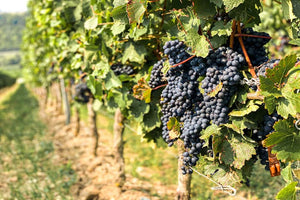The Pinot Grape Family Explained
May 30, 2022
There are a whole family of white wine grapes out there when it comes to white wine, it is not a case of one grape fits all - grapes used to make white wine are not the same. Different grape varieties are used to create different varieties of white wines - this helps to achieve a different taste in each white wine. We are going to be discussing the difference between the Pinot grape varieties and the difference in the wine they produce too.
Grapes can be grown in different countries within different locations and climates, which affects what they taste like - the environment in which white wine grapes are grown greatly affects the taste, this is why they are grown in these certain places and climates, to achieve certain tastes and acidities.
The Pinot Family
The three most famous white wine grape varieties are Pinot Grigio, Pinot Gris and Pinot Blanc.
Most people have more than likely heard of Pinot Grigio, whilst Pinot Blanc is probably the least known type of grape out of the three. This Pinot family, just like a family, do have similarities - but they also have their exciting differences too.
Which is why we are here to discuss the differences between these three main types of Pinot grapes, so keep reading to find out more about this white wine grape family and to have these grape types explained.
The Similarities of the Pinot Family
All Pinot related grapes and part of the same grape family, Pinot Grigio and Pinot Gris are both made from the same grape variety and both Pinot Grigio and Pinot Gris originated from France where ‘Gris’ is the word for grey in French.
The Pinot Gris and Grigio grapes both have a greyish/purple colour to them, and the wines they produce have a similar flavour profile but also have minor style differences depending on where and how they are made and depending on the fermenting process.
All three grapes Pinot Grigio, Gris and Blanc are colour mutations from the grape Pinot Noir. Just because these Pinot grapes are from the same family of grapes and are genetically the same, does not mean the grapes taste the same once made into wine - the wine's character can be influenced by different factors.
Pinot Noir
Pinot Noir grapes contain the largest amount of active anthocyanins (this is one component that contributes to the colour of the grape), hence the darkest colour of the wine, Pinot Noir is a red wine. Pinot Blanc on the other hand, is a mutation of Pinot Noir and has the least amount of anthocyanin in it.
Where Are They All Grown?
The Pinot Grigio grape is grown in Northern Italy, in mountainous regions. The Pinot Gris grape is grown in its home country of France and is also concentrated in Alsace, New Zealand, Australia and California. The Pinot Blanc grape is mostly found in Germany and Northern Italy where wines are refreshing, peachy and dry.
Pinot Grigio
Pinot Grigio is ultra-fresh and a zippy wine, the difference between Pinot Grigio and Pinot Gris is in the production. Pinot Gris tends to be crafted towards a slightly rounder, food-friendly flavour profile.
Pinot Grigio tends to be more mass-produced as it is particularly popular across the U.S.A and is a staple that we often pick up and buy in the supermarket.
With fruity and zippy white wines dominating the market, this does not mean that there is less room for the more complex, structured and aged wines.
Cheaper Pinot Grigio is mass-produced and steel tank aged, with a lower amount of natural acidity in the grape as it is preserved as much as possible. This is where you get a refreshing, zingy and citrusy taste from.
Higher end Pinot Grigio and also Pinot Gris tends to go through barrel ageing, which mitigates the zing and acidity and enriches the fruit, even with a bit of wood spice, which is why you end up paying a higher price for these types of wines. Any wine that requires some level of ageing will add to the overall price as the longer and more complex the process is to create and produce the wines.
What to Eat With Pinot Grigio
Pinot Grigio's light and charming notes of citrus, peach and floral aromas make it brilliant to drink both on its own or with salads and creamy cheeses.
As a delicate and neutral wine, Pinot Grigio pairs best with fresh flavours - think anything lightweight and summery as a good pairing, so salads, chicken, seafood as well as light pasta dishes and risottos. Avoid anything too heavy with this wine, such as heavy sauces or creams and added vinaigrettes.
Pinot Gris
A dryer and lighter member of the family Pinot Gris gives us apricot and peach notes with a hint of smoke and well-balanced acidity - giving a much richer style to the wine. It has a slightly higher price point compared to Pinot Grigio. Pinot Gris can actually be picked late harvest and turned into a rich dessert wine.
What to Eat With Pinot Gris
The complexity and richness of this wine make it a perfect pairing with a heartier kind of dish such as a fish in cream sauce, pork, duck, chicken or turkey as the main course with a side of seasonal vegetables, raw fish and lighter meals also work really well.
Pinot Blanc
Pinot Blanc is very versatile, it's used in still wines and sparkling and can actually be blended with Chardonnay. It may not be the most glamorous of all the wine grape families and it is from the region is typified by almond aromas with a hint of spice.
Pinot Blanc has a rounder expression than Pinot Gris and Pinot Grigio, so unlike the often brighter fruity flavours of the other two Pinots, Pinot Blanc can tend towards apple pie and smokier flavours and it can be oaks for a bit more richness.
What to Eat With Pinot Blanc
Pinot Blancs pair perfectly with roast chicken, salad and other light meats along with cheeses, seafood, pasta, Quiche Lorraine works particularly well and anything creamy or acidic sauces are also excellent choices.
The Pinot Grigio and Pinot Gris Grape
You can get a real variety of flavours when it comes to the grapes Pinot Grigio and Pinot Gris that is because it reacts to terroir sensitively.
Terroir is a French term that is used to describe the environmental factors that affect a crop, so different flavours can be achieved from these same grapes depending on the environment in which the grapes are grown and fermented.
These grapes usually prefer cool climates and hillsides which is why they are grown in North East Italy and North East France. The temperature, weather and ageing style will all affect these grapes in different ways depending on the process that is used on them.
Final Note
We hope you have been informed on the main different types of white wine grape and what they can all add to different variations of wine.
If you are a lover of wine, be sure to check out our low calorie, low sugar wine options here at ThinK Wine, including our Vegan Sparkling Rosé Wine along with our Vegan Prosecco if you are more of a prosecco fan - all our products have the same low calorie and low sugar benefits along with them being vegan, what's not to love! As many wines are unknowingly made with animal products, find out more about that here.


